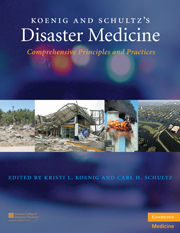Book contents
- Frontmatter
- Contents
- List of Contributors
- Contributor Biographies
- Foreword
- Preface
- Acknowledgments
- PART I CONCEPTUAL FRAMEWORK AND STRATEGIC OVERVIEW
- PART II OPERATIONAL ISSUES
- PART III CLINICAL MANAGEMENT
- SECTION A CBRNE AND HAZMAT
- SECTION B ENVIRONMENTAL EVENTS
- 32 Floods
- 33 Cyclones/Hurricanes/Typhoons
- 34 Tornadoes
- 35 Earthquakes
- 36 Tsunamis
- 37 Winter Storms
- 38 Extreme Heat Events
- 39 Volcanoes
- Index
- Plate section
- References
39 - Volcanoes
from SECTION B - ENVIRONMENTAL EVENTS
Published online by Cambridge University Press: 05 August 2011
- Frontmatter
- Contents
- List of Contributors
- Contributor Biographies
- Foreword
- Preface
- Acknowledgments
- PART I CONCEPTUAL FRAMEWORK AND STRATEGIC OVERVIEW
- PART II OPERATIONAL ISSUES
- PART III CLINICAL MANAGEMENT
- SECTION A CBRNE AND HAZMAT
- SECTION B ENVIRONMENTAL EVENTS
- 32 Floods
- 33 Cyclones/Hurricanes/Typhoons
- 34 Tornadoes
- 35 Earthquakes
- 36 Tsunamis
- 37 Winter Storms
- 38 Extreme Heat Events
- 39 Volcanoes
- Index
- Plate section
- References
Summary
OVERVIEW
Introduction
An understanding of how people are killed and injured in volcanic eruptions is essential for advancing disaster mitigation measures as well as for managing casualties in actual events (Table 39.1). The main aim of disaster medicine is the prevention of direct human deaths and injuries and reducing economic losses that can indirectly affect health through increasing poverty and inequality. A surprisingly large number of lethal phenomena are associated with eruptions, and health hazards can arise even when volcanoes are in a state of apparent repose. Compared with other types of disasters such as floods, wind storms, and earthquakes, volcanic eruptions occur much less frequently. In recent decades there were on average only two–four events worldwide per year that involved fatalities and people living near an active volcano have only a low statistical risk of a serious event happening in their lifetimes.
The reactivation of a volcano in a densely populated area should trigger a state of emergency, like a warning for an approaching hurricane or storm surge. Forecasting an eruption in a state of unrest requires a team of experienced volcanologists equipped with the latest monitoring technology who can make a rapid appraisal based on what is known about the particular volcano and by drawing analogies from similar volcanoes and how they behave. Although most of these potential crises do not lead to a major eruption and states of unrest can remain in place for years, the uncertainty of forecasting eruptive behavior and the possibility that a serious eruption can happen with little to no warning means that evacuation decisions may have to be made very quickly.
- Type
- Chapter
- Information
- Koenig and Schultz's Disaster MedicineComprehensive Principles and Practices, pp. 632 - 642Publisher: Cambridge University PressPrint publication year: 2009



